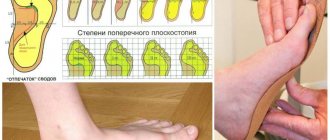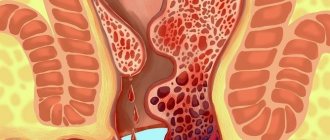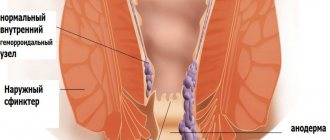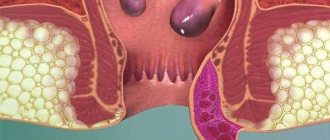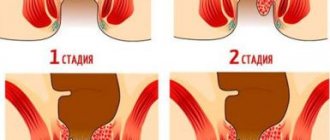Most of humanity suffers from such an unpleasant disease as hemorrhoids. Some people go to the hospital at the first sign of illness, while others wait and endure, and then still run to the doctor. This intestinal pathology mainly affects people who lead a sedentary lifestyle. Thus, it turns out that every office worker can get hemorrhoids, but is this true? Let's look at how to independently determine whether you have hemorrhoids and what kind of disease it is.
A little about the disease
All people have hemorrhoids, which look like folds that appear on the surface of the rectal mucosa. They, together with the muscles, do not allow feces to leave the intestines before the bowel movement process.
Hemorrhoids are varicose veins of the rectum.
Venous dilatation of the veins of the anus, or hemorrhoidal inflammation, is a pathology that is associated with blood stagnation and severe tension. This leads to disruption of the position of hemorrhoidal folds. Together with the rectal mucosa, they move down to the anus. This causes improper blood flow to the folds and they begin to grow and appear on the outside of the anus.
Factors that provoke the appearance of formations are:
- alcoholic drinks and smoking;
- excess weight;
- problematic bowel movements;
- sedentary lifestyle;
- regularly lifting heavy objects;
- frequent anal sex;
- pregnancy and childbirth.
Hemorrhoids can also occur as a result of poor nutrition, namely, among lovers of spicy and spicy foods.
Pregnancy can lead to this disease
Causes of the disease
The main factors contributing to the disease are considered to be:
- Chronic constipation;
- Venous congestion in the pelvic organs, which develops with a sedentary lifestyle, as well as excess weight;
- Spastic phenomena of the internal sphincter;
- Poor circulation in the intestines due to excessive consumption of strong alcoholic beverages, the predominance of dishes in the menu consisting mainly of fatty and fried foods, the use of certain medications;
- Inflammatory diseases of the rectum and pelvic organs in a chronic form, leading to the spread of infection and poor circulation.
Share the article on social media. networks:
How does the disease begin and what are its first symptoms?
Many people realize that they have a bowel problem only after they see blood on paper or underwear. But this is only one of the few signs of the disease. How can you tell whether you have hemorrhoids or not? Its symptoms are:
- Pain during movement, sitting, and during bowel movements.
- Feeling the bumps with your hands, sometimes causing sharp pain.
- Unpleasant sensations near the anus, there may be burning or itching.
- Heaviness in the abdomen, as well as a sensation of a foreign body in the anus.
- The presence of blood in the feces or bleeding during bowel movements.
Reviews
People write in reviews that the easiest way to avoid the appearance or exacerbation of hemorrhoids is if you eat right, then the stool will be soft, and this will be the best “cure”.
Experienced patients in their comments advise other people suffering from this disease to eat a lot of foods high in fiber, we are talking about fruits, vegetables, and cereals. This softens the stool, increasing its volume, which is good for avoiding increased pressure in the abdominal area. True, it is recommended to introduce dietary fiber into your diet in small portions so that it does not provoke increased gas formation. It is recommended to avoid seasonings, spicy foods and alcohol.
Many also advise drinking a lot of fluids when dealing with this problem. A day, as a rule, it is recommended to drink from six to eight glasses of water or any other liquids (alcohol, of course, is not included here) so that a person’s stool is soft and cannot injure the walls of the rectum.
How do you know if you have hemorrhoids? If there is discomfort during bowel movements, pain, and blood remains on toilet paper and underwear, then the disease has most likely developed. For an accurate diagnosis, you should visit a doctor.
How do you know if you have hemorrhoids?
Dilation of the veins of the anus is a disease during which inflammatory processes and thrombosis appear in the blood supply to the rectum.
The patient experiences discomfort in the anal area, as well as during defecation. But many people are in no hurry to see a doctor with this problem and try to somehow independently determine whether it is hemorrhoids or not. Patients forget that some intestinal diseases may have symptoms identical to hemorrhoids. And only a doctor can make a correct diagnosis after a thorough examination.
The main cause of the disease is inflammation, which is located under the skin in the perineum, in the area of the plexus of blood vessels. Hemorrhoids happen:
- External. In the external (external) form of hemorrhoids, inflammation affects the plexuses of blood vessels located under the skin of the perineum.
- Internal. The pathological process begins in the walls of the rectum.
But, regardless of the type of pathology, areas of the rectum become inflamed, venous blood flow is disrupted, and muscle tissue is depleted.
Types of hemorrhoids
Initially, the nodes enlarge, which contributes to their displacement towards the anus. If the pathology is not treated, they eventually begin to fall out of the anus. Then the answer to the question: “How can I tell if I have hemorrhoids?” – there will be a simple feeling of the anus. With clean, dry hands, you can detect nodules or even clusters of choroid plexuses near the anus.
At the initial stage, hemorrhoids are rarely a concern. That's why most people don't notice it. Concern begins when burning, itching, and swelling appear near the anus. It happens that after a bowel movement, slight bleeding begins. If these signs are not paid attention to and are not treated, the pathology develops into the second stage. During which there is difficulty in bowel movements due to severe pain. The patient tries to put off visiting the bathroom for as long as possible, which provokes increased pressure in the nodes and is a source of inflammation.
Treatment methods
After making the correct diagnosis, the doctor decides what treatment to prescribe to the patient. But at all stages, treatment is carried out, which allows you to relieve the symptoms of the disease, that is, reduce pain by stopping bleeding. When hemorrhoids belong to the first or second stage, it can be cured provided that conservative therapy is used, that is, medications that relieve discomfort and prevent complications, as well as contribute to the postoperative rehabilitation of patients. The best results are obtained by the joint use of medicinal drugs for external or internal use.
If after a week no positive changes are observed, you should definitely undergo a re-examination by your proctologist, who should suggest another method of treatment.
When hemorrhoids are in the second or third stage, it will be impossible to cure it with medications alone; in this case, minimally invasive methods are used, which, unlike operating rooms, are less traumatic for patients; patients spend less time in the hospital and recover faster. These include:
- Application of infrared radiation. With the help of it, the doctor acts on hemorrhoids with high temperature, cauterizing the vessels. Such an operation will not require anesthesia (except in cases where this area is highly sensitive in patients) and is the least traumatic. Coagulation is also possible using laser beams.
- Use of sclerotherapy. The patient is injected into the area of hemorrhoids with a special substance that glues the walls of blood vessels. It is usually injected into no more than two nodes so that patients do not develop pain. The next session is carried out two weeks later.
- Performing ligation of hemorrhoids with latex rings. This technique is most often used for the treatment of hemorrhoids in the elderly who have diseases that complicate the course of treatment. Against this background, a small latex ring is placed on the node, gradually squeezing it, which leads to its necrosis and rejection. Bleeding does not occur in this case, since the stump is covered with a ring. Subsequently, healthy connective tissue is formed in its place. The procedure is considered virtually painless, with little trauma.
- Application of cryotherapy. With this method, hemorrhoidal nodes are exposed to low temperatures, then after thawing they die, the resulting wounds heal over time, and connective tissue is formed in place of the node. The operation is performed under local anesthesia.
All minimally invasive treatment methods are used only if there is no exacerbation of hemorrhoids. When hemorrhoids enter the acute stage, it is necessary, first of all, to eliminate inflammation and reduce bleeding.
How do you know if hemorrhoids are internal?
Under the mucous membranes of the lower part of the anal canal is the localization of internal hemorrhoids. They do not fall out, there is no pain or bleeding. The patient can only feel discomfort in the anal canal, as if there is a foreign object there. But this is only at the first stage of the disease, since the formations are still small in size. Only a doctor can determine whether it is hemorrhoids or not.
Under the influence of negative factors, the nodes begin to fill with blood and increase in size. Blood clots appear, veins lose elasticity and strength. Self-treatment can only aggravate the disease and contribute to the development of its chronic form.
But a specialist will tell you how to understand that you have hemorrhoids without feeling the anus. You definitely need to see a proctologist if you have bleeding from the anus or if you feel discomfort in the rectum or anus.
After childbirth
Usually, in the last months of pregnancy, women are forced to lead a sedentary life, which is not conducive to health. During childbirth, the muscles in the perineum tend to tense, stretching the cavernous bodies of the rectum. With severe stretching of the muscles in the perineum, weakening of the anal sphincter and prolapse of the nodes are likely.
How to understand that hemorrhoids appeared after childbirth? Often women who have given birth confuse the symptoms of hemorrhoids with the consequences of childbirth and do not immediately consult a doctor, thereby provoking the development of the disease.
Hemorrhoids in young people
Inflammation of hemorrhoidal cones “gets younger” every year. A few years ago, only older people knew about it. Today the disease occurs in young boys and girls. Why has this pathology of the rectum become so younger?
Sedentary work can lead to hemorrhoids
The causes of hemorrhoids are unchanged. This:
- bad habits;
- great physical activity;
- prolonged sedentary work;
- sedentary lifestyle;
- genetic predisposition.
Anal sex is often the cause of pathology in young people. Some couples practice it too often; small cracks and wounds around the sphincter provoke the development of varicose veins of the rectum. External hemorrhoids are dangerous because pinching of the node can occur, which can only be treated with urgent surgical intervention. If you often practice anal sex, you must know how to identify hemorrhoids yourself. After all, this disease is a constant companion of such dubious pleasure.
Patient Interview
Doctors call this taking a medical history. This is not yet actual research, but something like information preparation. Like other diseases, hemorrhoids have their own etiology, that is, their origin.
| Patient diagnosis | Common diagnoses after examination |
| Painful sensations 50% Bleeding 40% Swelling of perianal skin 25% Gastrointestinal tract dysfunction 18% Itching and burning 15% Discharge from the anus 12% | Hemorrhoidal disease 40%, anal fissures 18%, suppuration 16%, condyloma 7%, eczema 6%, tumor 4%, other pathologies 9% |
If you suspect symptoms of hemorrhoids, you should consult a proctologist!
Only a doctor can make the correct diagnosis
The doctor’s task is to identify various provoking factors in the patient’s life:
- gastrointestinal disorders;
- errors in diet;
- excessive alcohol consumption;
- physically inactive life, sedentary work.
Quite often, expectant mothers or women who have recently given birth come to doctors. In patients in this category, hemorrhoids are caused by specific reasons: pressure on the intestines of the enlarged uterus, circulatory disorders, and efforts during childbirth.
At the end of the interview, the doctor begins the diagnosis. This is a complex procedure and its techniques are different. It is impossible to say in advance what kind of research will be carried out; this is decided by a specialist. Possible options will be discussed below.
Determining hemorrhoids at home
People who first encountered discomfort in the rectum ask the question: “How to understand that hemorrhoids have appeared at home?” After all, itching can be caused not only by hemorrhoids, but also by helminths. If your body type allows, you can palpate yourself. And, if you find bumps in the anus that resemble a lump, this will be the first sign.
There is no need to ignore the symptoms of the disease, since without treatment it will develop quickly, and the discomfort will only intensify, and new signs will appear that indicate the occurrence of pathology in the rectum.
Hemorrhoids greatly affect a person’s life; it is difficult for the patient to concentrate on work or on solving any issues. It is uncomfortable for him to sit and lie down. When bleeding occurs, anemia may develop. Ulcers may appear on the mucous membrane, which without proper treatment can lead to infection with various microorganisms and bacteria.
If you have palpated yourself at home and found any formations on your own, make an appointment with a doctor. He certainly knows how to identify hemorrhoids. The specialist will prescribe tests and examinations that will help confirm or refute your fears.


